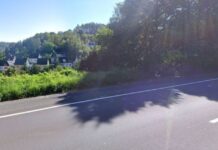Trump nominates former Michigan congressman Pete Hoekstra to be ambassador to Canada
U.S. president-elect Donald Trump has tapped former Michigan congressman Pete Hoekstra to be his ambassador to Canada.
Hoekstra previously served as ambassador to the Netherlands during Trump’s first presidency

U.S. president-elect Donald Trump has tapped former Michigan congressman Pete Hoekstra to be his ambassador to Canada.
Hoekstra served in the U.S. House of Representatives from 1993 until 2011. He also previously served as Trump’s ambassador to the Netherlands in the former president’s first administration.
“In my second term, Pete will help me once again put America first,” Trump said in a statement announcing the nomination.
“I am confident that he will continue to represent our Country well in this new role.”
More to come
Published at Fri, 01 Nov 2024 08:11:21 +0000
Artist says he was surprised people mistook his seashell sculpture for a poop emoji
As It Happens6:23Artist says he didn’t see his sculpture’s resemblance to the poop emoji until after its construction
At no point in the months-long construction of his sea snail-shaped structure did artist Mark Antony Haden Ford think his art looked like anything but an aquatic creature.
But to some folks, the piece’s spiral shape resembles the poop emoji more than what was intended: a type of sea snail called a periwinkle.
“This was an intentional sculpture,” Ford told As It Happens host Nil Köksal. “[But] spirals occur in nature, right? So it can be interpreted as another thing.”
Ford says the artwork was commissioned by the local government in Chichester, England, to celebrate the Medmerry Nature Reserve that the installation sits on. Like much of Ford and his wife Rebecca’s sculptures, it was made from woven willow branches.
The goal was to create a structure that visitors of the reserve could walk into for shelter from the elements. “There’s no shelter at all. It’s [a] very exposed section of coastline. And so it seemed to make sense to have something you could sit inside,” said Ford.
Ford said he drew inspiration from archaeological excavations that took place on the site a few years ago. One such dig revealed the remains of periwinkle shells in a medieval willow basket.
“It just seemed to make sense that it would be made of willow, would be some sort of shelter, and it would be the shape of a periwinkle,” Ford said.
As an environmental artist, Ford said he avoided painting the structure in order to keep its ecological impact to a minimum — though he admits painting it white might have made it look more like a seashell.

According to local media, visitors of the nature reserve have gotten a laugh out of the structure’s shape. “I couldn’t stop laughing when I saw it. I thought it was a joke at first,” a visitor told The Telegraph.
Others have drawn additional meaning from the artwork’s unintended resemblance.
“Some people have been saying to me, ‘If people see the shape of a poo, maybe that’s a metaphor for what we’re doing to our coastline — just allowing poo to be spilled into it’,” Carolyn Cobbold, project leader for the environmental group Manhood Peninsula Partnership, told the BBC.
While Ford defends the seashell design, he doesn’t mind that some people interpret it differently. “I think it’s great, actually, that people can see what they want to see.… People can interpret it the way they want.”
Having worked as an artist alongside his wife for 20 years, Ford said this isn’t the first time his art has been mistaken, either.
The two wove a “tetrapodicus” — a mythical four-legged beast with a long neck — in the forest outside of Montreal last month, which some mistook for a bear or a dinosaur. And a 12-metre-long mustache they crafted on the side of a building looked like two whales kissing to some who laid eyes on it.

Ford says the reception won’t dictate what he and his wife weave next. They’re already building a giant acorn sculpture in London, and plan to construct a willow Christmas tree next week — for the very same local government that commissioned the periwinkle shell.
But in the future, “I think we’ll stay away from sculptures which can be so easily misinterpreted,” Ford said.
Published at Wed, 20 Nov 2024 22:51:06 +0000







